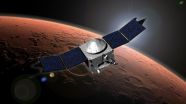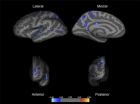(Press-News.org) NASA's MAVEN spacecraft has provided scientists their first look at a storm of energetic solar particles at Mars and produced unprecedented ultraviolet images of the tenuous oxygen, hydrogen and carbon coronas surrounding the Red Planet, said University of Colorado Boulder Professor Bruce Jakosky, the mission's principal investigator.
In addition, the new observations allowed scientists to make a comprehensive map of highly variable ozone in the Martian atmosphere underlying the coronas, he said. The spacecraft entered Mars' orbit Sept. 21 and is in the process of lowering its orbit and testing its instruments. The $671 million Mars Atmosphere and Volatile EvolutioN mission, or MAVEN, was launched toward Mars on Nov. 18, 2013, to help solve the mystery of how the Red Planet lost most of its atmosphere.
"Everything is performing well so far," said Jakosky of CU-Boulder's Laboratory for Atmospheric and Space Physics. "All of the instruments have now been turned on, and although they are not yet fully checked out, they are functioning nominally.
"All the instruments are showing data quality that is better than anticipated at this early stage of the mission," said Jakosky, also a professor in CU-Boulder's geological sciences department. "The spacecraft is performing beautifully. It's turning out to be an easy and straightforward spacecraft to fly, at least so far. It really looks as if we're headed for an exciting science mission."
Solar Energetic Particles (SEPs) are streams of high-speed particles blasted from the sun during explosive solar activity like flares or Coronal Mass Ejections (CMEs). Around Earth, SEP storms can damage the sensitive electronics on satellites. At Mars, they are thought to be one possible mechanism for driving atmospheric loss.
A solar flare on Sept. 26 produced a CME that was observed by NASA satellites on both sides of the sun. Computer models of the CME propagation successfully predicted the disturbance and the accompanying SEPs would reach Mars on Sept. 29.
"After traveling through interplanetary space, these energetic particles, mostly protons, deposit their energy in the upper atmosphere of Mars," said SEP instrument lead Davin Larson of the Space Sciences Laboratory at the University of California, Berkeley. "A SEP event like this typically occurs every couple of weeks. Once all the instruments are turned on, we expect to also be able to track the response of the upper atmosphere to them."
The hydrogen and oxygen coronas of Mars are the tenuous outer fringe of the planet's upper atmosphere, where the edge of the atmosphere meets space. In this region, atoms that were once a part of carbon dioxide or water molecules near the surface can escape to space, according to MAVEN scientists.
Water and carbon dioxide control the climate, so following them allows scientists to understand the history of Mars over the last four billion years and to track the change from a warm and wet climate to the cold, dry climate present today. MAVEN observed the edges of the Martian atmosphere using the CU-Boulder-built Imaging Ultraviolet Spectrograph (IUVS), which is sensitive to the sunlight reflected by the atoms.
"With these observations, MAVEN's IUVS has obtained the most complete picture of the extended Martian upper atmosphere ever made," said IUVS team member and CU-Boulder doctoral student Mike Chaffin of the Department of Astrophysical and Planetary Sciences. "By measuring the extended upper atmosphere of the planet, MAVEN directly probes how these atoms escape to space. The observations support our current understanding that the upper atmosphere of Mars, when compared to Venus and Earth, is only tenuously bound by the planet's weak gravity."
IUVS also helped scientists create a map of the atmospheric ozone on Mars by detecting the absorption of ultraviolet sunlight by the molecule. "With these maps we have the kind of complete and simultaneous coverage of Mars that is usually only possible for Earth," said CU-Boulder Research Associate Justin Deighan, an IUVS team member from LASP. "On Earth, ozone destruction by refrigerator CFCs is the cause of the polar ozone hole. On Mars, ozone is just as easily destroyed by the byproducts of water vapor broken down by ultraviolet sunlight.
"Tracking the ozone lets us track the photochemical processes taking place in the Martian atmosphere," said Deighan. "We'll be exploring this in more complete detail during MAVEN's primary science mission."
There will be about two weeks of additional instrument calibration and testing before MAVEN starts its primary science mission. This includes an end-to-end test of relaying data between NASA's Curiosity rover on the surface of Mars and Earth using the MAVEN mission's Electra telecommunications relay. The mission is aiming to start science in early to mid-November.
CU-Boulder provided two science instruments and leads science operations, as well as education and public outreach, for the MAVEN mission, which has contributed roughly $300 million to Colorado's economy. UC Berkeley's Space Sciences Laboratory also provided four science instruments for the mission.
INFORMATION:
NASA's Goddard Space Flight Center in Greenbelt, Md., manages the MAVEN project and provided two science instruments for the mission. Lockheed Martin of Littleton, Colo., built the spacecraft and is responsible for mission operations. NASA's Jet Propulsion Laboratory in Pasadena, Calif., provides navigation and Deep Space Network support, as well as the Electra telecommunications relay hardware and operations.
Contact:
Bruce Jakosky, 303-492-8004
bruce.jakosky@colorado.edu
Justin Deighan, 303-735-0542
justin.deighan@colorado.edu
Michael Chaffin, 303-517-0319
michael.chaffin@colorado.edu
Jim Scott, CU-Boulder media relations, 303-492-3114
jim.scott@colorado.edu
For more information about MAVEN visit http://www.nasa.gov/mission_pages/maven/main/index.html or http://lasp.colorado.edu/home/missions-projects/quick-facts-maven/.
HEIDELBERG, 14 October 2014 – Researchers from Stanford University School of Medicine have discovered a link between a protective mechanism used by cells and the activation of muscle stem cells. Cells use autophagy to recycle cellular "building blocks" and generate energy during times of nutrient deprivation. The scientists report in The EMBO Journal that when this protective mechanism is operational it also seems to assist in the activation of stem cells.
"Our study reveals that when stem cells emerge from a quiescent state there is a rapid and dramatic change in ...
Humans have a focus on the short term. We are more interested in a potential benefit if we can get it now.
The ability to delay gratification has been studied in children with the "marshmallow test": a child can have one treat now, or two if he or she can wait a few minutes without gobbling the first treat.
Psychologists and economists have shown that similar trends can be observed and measured in many spheres of life. They call the tendency for the perceived value of a delayed benefit to diminish "delay discounting."
Now researchers at Marcus Autism Center are studying ...
Cyclone Hudhud made landfall in east-central India on Oct. 12 and caused a lot of damage and several fatalities as it moved inland and weakened to a remnant low pressure area. NASA saw those remnants on Oct. 14.
When NASA's Aqua satellite passed over Indochina, the Moderate Resolution Imaging Spectroradiometer or MODIS instrument provided picture proof that the remnants of Typhoon Hudhud were still over India, Nepal, and China. Aqua passed over the region on Oct. 14 at 08:05 UTC (4:05 a.m. EDT).
Infrared satellite imagery and multispectral satellite imagery indicated ...
On 3 October 2014, the European Medicines Agency (EMA) hosted a meeting with representatives of Rare Cancers Europe (RCE) to discuss RCE's recent publication of a consensus paper on the methodology of clinical trials in rare cancers (1).
Rare Cancers Europe (RCE) is a multi stakeholder initiative promoted by ESMO (representing healthcare professionals, patients and industry) dedicated to putting rare cancers on the European political agenda. In their consensus document, RCE argue that a higher degree of uncertainty should be accepted for regulatory as well as clinically ...
COLUMBIA, Mo. – Neurons are electrically charged cells, located in the nervous system, that interpret and transmit information using electrical and chemical signals. Now, researchers at the University of Missouri have determined that individual neurons can react differently to electrical signals at the molecular level and in different ways—even among neurons of the same type. This variability may be important in discovering underlying problems associated with brain disorders and neural diseases such as epilepsy.
"Genetic mutations found in neurological disorders ...
Under the rule of dictator Nicolae Ceausescu, thousands of Romanian children were placed in overcrowded orphanages with bleak conditions and minimal human contact. Even after the 1989 revolution, the legacy of institutionalization continued. Only recently has research and public concern over early childhood environments caused changes in policies.
University of Washington research on children who began life in these institutions shows that early childhood neglect is associated with changes in brain structure. A paper published this month in Biological Psychiatry shows ...
LEBANON, NH – The foundation of evidence-based research has eroded and the trend must be reversed so patients and clinicians can make wise shared decisions about their health, say Dartmouth researchers in the journal Circulation: Cardiovascular Quality and Outcomes.
Drs. Glyn Elwyn and Elliott Fisher of The Dartmouth Institute for Health Policy & Clinical Practice are authors of the report in which they highlight five major problems set against a backdrop of "obvious corruption." There is a dearth of transparent research and a low quality of evidence synthesis. ...
Researchers at Lund University in Sweden are testing a treatment for type 2 diabetes which targets the disease mechanism itself - and not just the symptoms. For the first time, knowledge about the individual patient's genetic risk profile is being used. The treatment completely restores the capacity to secrete insulin, which is impaired by the risk gene.
"The concept of treatment personalised to the individual's risk profile has great potential. Our results show that it is possible to block the effects of a common risk gene for type 2 diabetes", says Anders Rosengren, ...
Scientists from the University of York have released a report highlighting the gap between declining wild fish supplies and healthy eating advice recommending more seafood.
While the health benefits of eating fish have become better appreciated in recent years, many wild fish stocks continue to be overfished.
In a study published in Marine Pollution Bulletin, Dr Ruth Thurstan, now a Research Fellow at the University of Queensland, and Professor Callum Roberts, Professor of Marine Conservation at the University of York, used historical fisheries data and population ...
The results of their research have been published as the cover story of the renowned medical journal Cancer Cell.
Fatty liver disease – alongside fatty liver due to massive alcohol consumption – is mainly caused by excessive consumption of fat and sugar combined with a lack of exercise or a sedentary life style. This is referred to as non-alcoholic fatty liver disease (NAFLD). If NAFLD becomes chronic – e.g. through the constant uptake of high lipids and high sugar combined with lack of excercise a chronic inflammatory response is triggered in the liver ...




